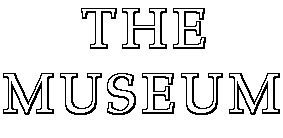
To skip to the links page for professional resources, click here. |

To skip to the links page for professional resources, click here. |
Museology is the science of running a museum, most frequently applied to the operations of the museum dealing with its collections rather than its administration or business operations.
A museum is ultimately a place where items of interest are kept. Most museums also have galleries, where items of interest are displayed. There are museums for almost every interest, from science to lingerie, and there are also galleries of every kind - but not every gallery is attached to a museum.
Items displayed in a gallery may belong to a private party, or a company, or an institution other than the gallery itself. The inventory of items kept in a gallery may be constantly changing. The gallery itself may never have a legal title of ownership for an item on display. The emphasis of a gallery is on presentation, and often on selling.
The emphasis of a museum may be almost anything, but usually one of the goals of a museum is to educate its constituency about the area of interest it represents - and a museum keeps items useful to this goal in its collection. The inventory of a museum collection may (but is less likely to) be constantly changing, but there is a focus and a central concept to guide what is taken in and what goes out. The museum may possess items on loan from individuals, companies, or other institutions - however, the museum is very likely to own, or have a legal role as perpetual guardian of, the majority of the items in its care. The museum may have no obligation to display its collection; it may only be available to researchers, for example.
It is the process of keeping these items of interest, and the additional process of educating a constituency, that is usually encompassed by the term museology.
The process of keeping items of interest.
The idea of keeping things seems very straightforward, and hardly seems to need a more complicated explanation. This is a false assumption. There are a multitude of questions which arise as a direct result of this simple statement:
What is worth keeping?
How many, and where are they obtained?
Where will the items be kept? (and this leads in turn to many questions)
What are the physical needs of the items? (do insects eat them? do they melt? do they mold? do they disintegrate, discolor, or disfigure in ultraviolet light? etc.)
How does one keep track of them?(where they are? who owns them? why are they important? etc.)
Should these items be insured? Could they be replaced?
And of course, the goal of educating a constituency about the area of interest served by the museum has one very basic question at its core:
How can the value of the items or the ideas represented be communicated?
This question usually leads to many others regarding the physical processes and concerns of object display: which, where, how many, physical demands, etc. Sometimes the questions center around publication, documentation, or illustration instead of physical display. All of these can be parts of the problem of educating a constituency.
The way in which these problems of 1) keeping items, and 2) educating a constituency with or about those items are resolved is the science of museology.